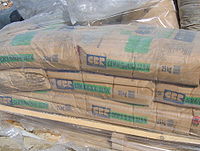
Photo from wikipedia
Abstract Influences of four polymer latexes with varied glass-transition-temperature (Tg) and colloidal surface properties on pore structure of hardened cement pastes (hcps) were investigated by means of mercury intrusion porosimetry… Click to show full abstract
Abstract Influences of four polymer latexes with varied glass-transition-temperature (Tg) and colloidal surface properties on pore structure of hardened cement pastes (hcps) were investigated by means of mercury intrusion porosimetry (MIP), nitrogen adsorption measurement (NAM) and SEM. MIP measurement indicates that polymer addition leads to increase of total pore volume and threshold pore size, whereas NAM shows that pore volume in the range of 2–100 nm decreases with addition of polymers, implying a sealing effect. The conflicting results between MIP and NAM originate from destruction and movement of the polymer phase by high pressure mercury intrusion during MIP measurement. SEM reveals that low-Tg polymers form continuous film while high-Tg polymers remain particle form in hcps. The film-forming polymers provide stronger sealing effect than the non-film-forming polymers. Moreover, the non-adsorbing polymers exhibit stronger sealing effect than the adsorbing polymers due to their preferential locations in aqueous phase of fresh cement paste.
Journal Title: Cement and Concrete Composites
Year Published: 2019
Link to full text (if available)
Share on Social Media: Sign Up to like & get
recommendations!